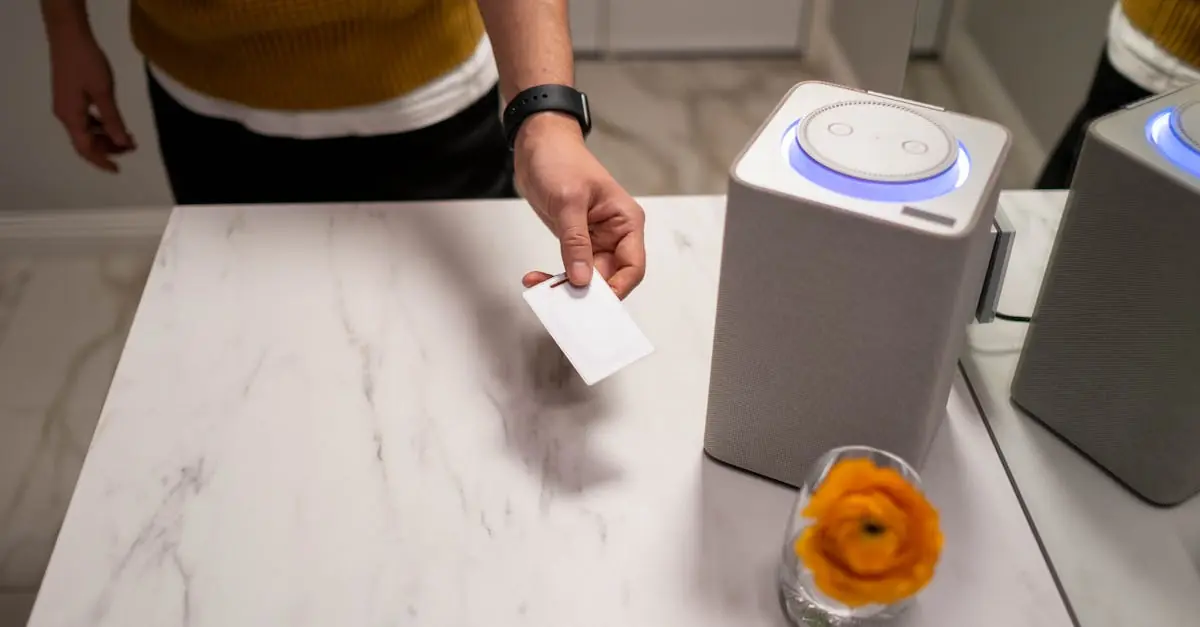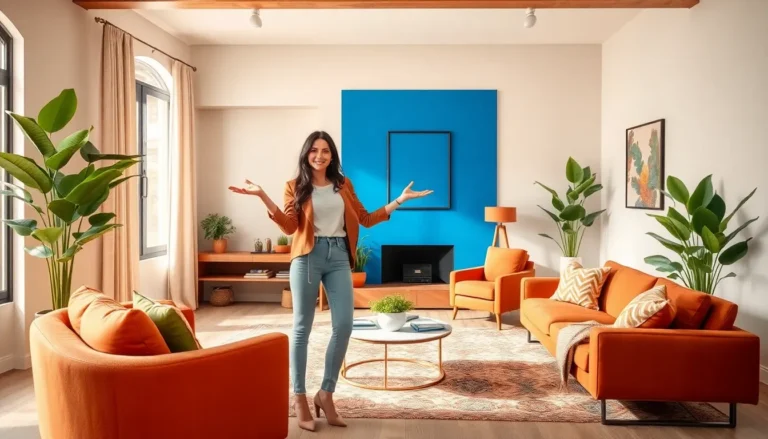Table of Contents
ToggleImagine walking into your home and having it respond to your every whim—lights dimming, temperature adjusting, and your favorite playlist serenading you. Welcome to the world of home automation controllers, where technology meets convenience in a way that even your cat will be impressed. These nifty devices are the brains behind your smart home, transforming mundane tasks into seamless experiences.
With a home automation controller, it’s like having a personal assistant who’s always on call, minus the coffee runs. From managing security systems to controlling entertainment, these controllers do it all with just a tap or a voice command. So why not bring your home into the 21st century? Embrace the future and discover how home automation can elevate your lifestyle, one smart device at a time.
Overview of Home Automation Controllers
Home automation controllers serve as the nerve center of smart homes. These devices enable centralized management of multiple systems, including lighting, temperature control, and entertainment options. Users benefit from enhanced convenience and energy efficiency through streamlined command execution.
Smart home controllers vary in functionality and design. Some rely on wireless connectivity, while others require wired systems. Universal compatibility is a key consideration; many controllers support diverse protocols such as Zigbee, Z-Wave, and Wi-Fi. This versatility allows for seamless integration of various smart devices.
The user interface plays a crucial role in functionality. Controllers may offer mobile apps, touchscreen displays, or voice commands for intuitive engagement. These features simplify control over multiple systems and enhance user experience.
Automation capabilities significantly elevate smart home technology. Users can set schedules or triggers based on specific conditions. For example, lights may automatically dim when a movie starts or the temperature can adjust based on the time of day. This level of personalization transforms the living environment into a responsive and adaptable space.
Security features are increasingly popular among home automation controllers. Many systems provide remote monitoring and alerts, enabling users to safeguard their properties effectively. This function adds a layer of peace of mind for homeowners.
Home automation controllers exemplify the integration of technology into daily life, offering convenience and enhanced lifestyle experiences. With a range of options and features, users can tailor settings to meet their specific needs, making home automation a smart choice for modern living.
Types of Home Automation Controllers
Home automation controllers fall into two main categories: wired and wireless, each offering distinct advantages and functionalities for smart home management.
Wired Controllers
Wired controllers connect directly to home systems, ensuring stable and reliable performance. Compatibility with various home technology components enhances their functionality. Installation of wired systems can require professional expertise, particularly in larger setups. Often, these controllers support multiple devices simultaneously, providing centralized control. Energy efficiency benefits come from the direct connection to power sources, minimizing the need for battery replacements. Examples include dedicated home automation panels that integrate with existing electrical systems.
Wireless Controllers
Wireless controllers offer flexibility and ease of installation. These devices often utilize protocols such as Wi-Fi, Zigbee, or Z-Wave for seamless connectivity. Convenience in setup allows users to place wireless controllers in various locations throughout their home. They also enable control through mobile apps or voice commands, enhancing the user experience. Generally, wireless controllers support a broad range of devices, making them a versatile option for many users. Battery-operated models eliminate the need for complex wiring, simplifying the installation process.
Features to Consider in Home Automation Controllers
Home automation controllers possess key features that optimize user experience and effectiveness. Users must explore these elements to ensure compatibility and functionality.
Compatibility with Smart Devices
Compatibility becomes essential when choosing home automation controllers. They must work seamlessly with various smart devices, including thermostats, lights, and security systems. Controllers supporting protocols like Zigbee, Z-Wave, and Wi-Fi offer extensive compatibility, enabling diverse device integrations. Selecting a controller that accommodates many devices enhances flexibility and usability. Additionally, universal compatibility ensures the integration of both existing devices and future technology, allowing a seamless expansion of the smart home ecosystem.
User Interface and Usability
User interface and usability significantly affect how individuals interact with home automation controllers. Touchscreen displays, mobile apps, and voice commands simplify control processes. A clear, intuitive interface makes it easy for users of all ages to engage with the system. Consideration of usability factors helps prevent confusion when accessing different functionalities. Responsiveness in commands further enhances user satisfaction, as immediate feedback promotes confidence in the technology. Therefore, the choice of controller should prioritize an effective user experience for all household members.
Popular Home Automation Controllers on the Market
Numerous home automation controllers enhance smart home functionality and user experience. Two notable options are Controller A and Controller B.
Controller A
Controller A stands out for its compatibility with major smart home protocols like Zigbee, Z-Wave, and Wi-Fi. This device features a sleek design, allowing it to fit seamlessly into any home decor. A user-friendly mobile app simplifies device management, enabling users to control lighting, temperature, and security systems from their smartphones. Automation features let users create schedules and routines for various connected devices, streamlining daily tasks. Robust security measures, including remote monitoring and notifications, provide added peace of mind. Overall, Controller A appeals to many homeowners seeking versatility and reliability in their home automation setup.
Controller B
Controller B excels in ease of installation and flexibility. With wireless connectivity options, it can be placed anywhere without hassle. The integrated voice command functionality enhances user interaction, allowing intuitive control over multiple devices. Notably, this controller supports an extensive range of smart products, promoting seamless integration in diverse ecosystems. Customizable automation settings enable users to personalize their home environment, adjusting settings based on time of day or specific triggers. Its clear touchscreen interface allows for direct interaction, making it easy for everyone in the household to use. Controller B remains a top choice for those wanting a convenient and efficient home automation solution.
Benefits of Using Home Automation Controllers
Home automation controllers provide numerous advantages that elevate the living experience. Convenience ranks high on the list, as these devices enable centralized control over various systems. Tasks like adjusting lighting, setting temperatures, and controlling entertainment systems become effortless with simple commands.
Energy efficiency also stands out as a key benefit. Home automation controllers optimize energy use by allowing users to program schedules. For instance, lights can turn off automatically when no one is home, reducing unnecessary energy consumption.
Enhanced security measures add another layer of appeal. Remote monitoring and instant alerts ensure homeowners stay informed about their properties. Such features contribute to peace of mind, knowing that systems are constantly monitored.
Flexibility in selection further enhances the advantages of these controllers. Both wired and wireless options cater to different user needs. Users benefit from the stable performance of wired systems while enjoying the ease of installation offered by wireless solutions.
Compatibility emerges as a significant factor in maximizing advantages. Home automation controllers that support multiple protocols allow seamless integration with existing devices. This flexibility ensures users can adapt their systems as new technologies become available.
User experience significantly influences the overall effectiveness of these controllers. Intuitive interfaces, whether through mobile apps or touchscreen displays, make navigation simple for users. Clear layouts facilitate efficient management, benefiting all household members.
Lastly, automation capabilities provide a personalized touch to home management. By setting specific triggers and schedules, users can create environments tailored to their preferences. This level of customization enhances comfort and aligns with modern living styles.
Home automation controllers represent a significant leap towards smarter living. By centralizing control of various home systems they make daily tasks easier and more efficient. With options ranging from wired to wireless controllers users can find a solution that fits their needs and preferences.
The ability to integrate multiple devices and protocols ensures a seamless experience tailored to individual lifestyles. Enhanced convenience energy efficiency and security features further solidify their value in modern homes. As technology continues to evolve embracing home automation controllers can lead to a more connected and comfortable living environment.







